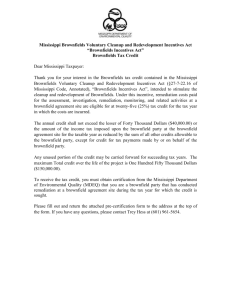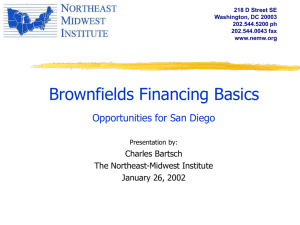T R B S
advertisement
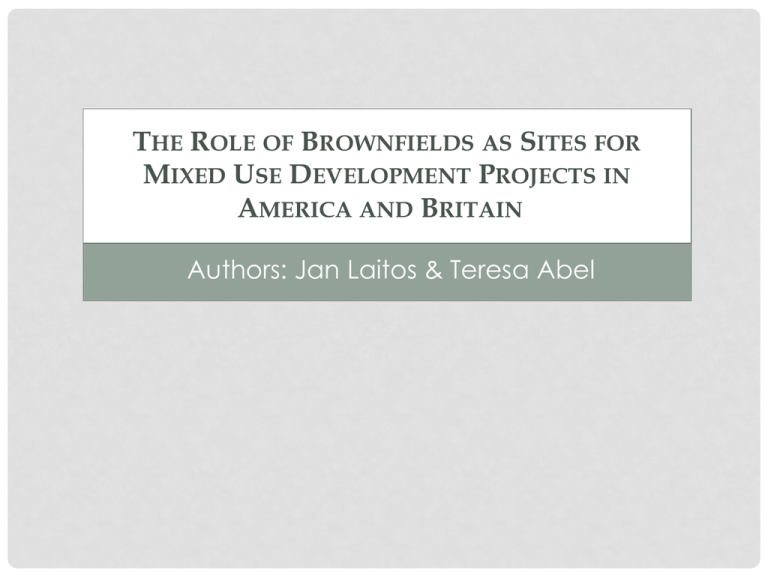
THE ROLE OF BROWNFIELDS AS SITES FOR MIXED USE DEVELOPMENT PROJECTS IN AMERICA AND BRITAIN Authors: Jan Laitos & Teresa Abel INTRODUCTION TRADITIONAL ZONING Before Mixed Use Development - Inefficient use of space MIXITE After Mixed Use Development – More Sustainable Mixed use development requires urban space that is free of existing uses. REDFIELDS & GREYFIELDS Redfields: Foreclosed Commercial Real Estate Greyfields: Abandoned Parking Lots and Shopping Centers GREENFIELDS • Usable Natural Open Space BROWNFIELDS • Before • After 1. Barriers to and benefits of brownfield development 2. Differing ways in which the United Kingdom and the United States have responded to the need for brownfield development 3. Varying degrees of success each country has experienced in actually creating mixed-use spaces from brownfield sites 4. Three case studies of mixed-use development sites in the United States BARRIERS TO AND BENEFITS OF BROWNFIELD DEVELOPMENT PART I A. Regulatory, Financial, and Physical Barriers to Brownfield Development Presence of Contaminants Remediation of Asbestos in Soil B. Challenges to Communities Where Brownfields are Left Undeveloped Reduced Property Values Visual Blight C. Benefits of Brownfield Redevelopment BROWNFIELD DEVELOPMENTS: A COMPARISON BETWEEN THE UNITED KINGDOM AND THE UNITED STATES PART II A. Responses of the Government and Private Sector in the United Kingdom • Promote Brownfield development to: • create new housing • encourage sustainable mixed use development • reduce pressure on greenfield development UNITED KINGDOM • Some public funding provided, but most funding must be raised by the private sector B. United States Response to Brownfields and Their Development • General Policy: Remove brownfields as lands that are not productive, and instead are depressing. • Promote development that is sustainable. UNITED STATES • Direct and comprehensive funding • Available through the Environmental Protection Agency’s (EPA’s) Brownfield Program and numerous other federal programs • Federal and state laws combat liability barriers • RCRA and CERCLA amended to ease liability concerns that could hinder development • Taxpayer Relief Act allows developers to deduct costs of clean-up • Environmental insurance VARYING SUCCESS IN THE UNITED STATES AND THE UNITED KINGDOM: WISHING TO CREATE MIXED USE SPACES FROM BROWNFIELD SITES PART III A. Implementation of Brownfield Redevelopment in the United Kingdom Brownfield development in London's Docklands has shown how wastelands can be brought back into use and profits made UNITED KINDGOM • The United Kingdom has had success in promoting brownfield development for residential use. IMPERIAL WHARF, CHELSEA, LONDON A handsome brownfield development providing 1,800 homes. Half of the scheme is affordable housing. ADMIRALTY QUARTER, PORTSMOUTH Once a car park, this site now provides over 500 homes whose residents enjoy lovely places to live and play. TARLING REGENERATION, SHADWELL, EAST LONDON Two hundred new homes in east London a successful example of a high-density, inner-city regeneration scheme. • However, greenfield development is still usually more economically feasible. • Private investors worry about costs of cleaning the land. • Limited space inhibits expansion. • Some argue that housing supply has decreased in general. • Governmental initiatives that discourage development on greenfields have not adequately addressed the underlying problems and potential liabilities associated with development on brownfields. B. United States • The EPA has prioritized reduction of barriers to brownfield development. • The EPA has promoted aggressively the idea that the implementation of mixed use development on urban brownfields can benefit every party involved. UNITED STATES • As a result of the EPA’s policies, there has been considerable interest and investment in brownfields. Redeveloped brownfield in Pittsburgh, Pennsylvania C. Case Studies • The following case studies are three examples of brownfield development in the United States. • The first is a terrific success story. • The second might be a success several decades into the future. • The third could have been a success, had economic conditions been better. • The goal for each development project was mixed use development. ATLANTIC STATION IN ATLANTA, GEORGIA ATLANTIC STATION • Atlantic Station is the United States’ largest urban brownfield redevelopment project ATLANTIC STATION • It sits on 138 acres in Atlanta, Georgia, where there once was a former steel mill ATLANTIC STATION • The transformation of Atlantic Station ultimately required an investment of over $2 billion. ATLANTIC STATION • Two key elements to its success: • the formation of numerous public-private partnerships • the strategic implementation of the comprehensive redevelopment plan ATLANTIC STATION • The site was issued “Tax Allocation Bonds” by the federal government. These bonds contributed up to $170 million in cleanup costs (to remove its brownfields status) and infrastructure. • The US Department of Transportation also provided funding to improve the sidewalks, streets, and traffic flow. • The private sector paid for the office, commercial, and residential development. More than 3,000 residents and 3,500 employees live and work in Atlantic Station. 11 acres of parks and greenspaces, bike trails, wide sidewalks, and numerous public transportation options GOWANUS CANAL IN BROOKLYN, NEW YORK GOWANUS CANAL • The canal is one of the most extensively polluted bodies of water in the United States GOWANUS CANAL • The EPA is in charge of funding the cleanup, but potential developers have to wait for the parties responsible for the pollution to be located, and liability to be assigned. GOWANUS CANAL • The designation of the Gowanus Canal as a Superfund site spurred the creation of the Gowanus Institute – a group of developers, planners, and environmental professionals dedicated to realizing the most productive development of the Gowanus neighborhood. • The institute has proposed a development plan that includes a 10,000-square-foot Whole Foods store that would sell only local products, a building for food production and culinary arts training, and a building for green and creative industries. This approach could produce as many as 950 jobs. GOWANUS CANAL • The case of the Gowanus Canal is an example of how government regulations can slow progress at brownfields - government cleanup requirements have caused redevelopment to be delayed by over a decade. GATES REDEVELOPMENT IN DENVER, COLORADO GATES RUBBER FACTORY Mixed-use development was seen as an opportunity to bring numerous benefits to the investors and to the community surrounding the site. GATES RUBBER FACTORY • In exchange for public subsidies and tax increment financing to aid in cleanup and development, developers agreed to comply with a long list of conditions stipulated by the local government and surrounding communities. Rendering of “Metropolitan Gardens” A MIXED USE URBAN ENVIRONMENT DESIGNED FOR THE SITE OF THE FORMER GATES RUBBER FACTORY GATES RUBBER FACTORY • The redevelopment plan was never fully realized due to the collapse of the real estate market in 2008. GATES RUBBER FACTORY The site remains a Denver eyesore and an example of an opportunity costthe loss of jobs in transforming the site, and the lack of benefits that would have followed, economically and environmentally, had the site been redeveloped. GATES RUBBER FACTORY • Many lessons can be learned by understanding the financial obstacles that eventually put this otherwise model redevelopment goal on hold. CONCLUSION • The strategy used for development of Atlantic Station can be implemented in other brownfield projects. • The Gowanus Canal development project should be examined when considering the potentially hindering effects of government involvement. • The Gates Rubber brownfield project is an example of the benefits that private-public partnerships can bring to mixed use brownfield development. CONCLUSION • The United States has succeeded largely because of: • Incentives it provides for private investors to engage in the mixed use development of brownfields. • The EPA’s efforts to remove the unique legal obstacles to development. CONCLUSION • The United Kingdom confronts problems similar to those faced by the United States. CONCLUSION • The UK should consider reforming its policies to provide incentives that convince investors of the unique social and economic benefits of sustainable brownfield development: • limiting liability • promoting voluntary cleanup / reduce investment risks • Promote mixed use development by providing job training and education, becoming more involved with encouraging local communities to embrace mixite, and reducing regulatory obstacles that inhibit the allocation of funding for cleanup and new infrastructure at brownfield sites THE END
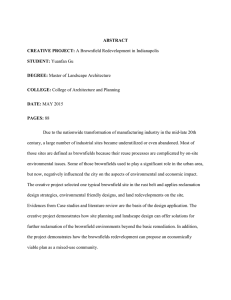
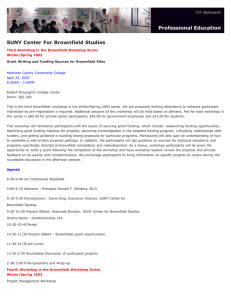
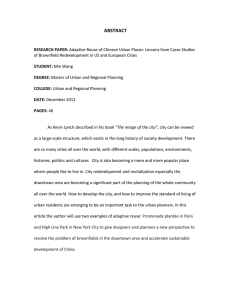
![Car Wash - Teachers [] - Carnegie Mellon University](http://s3.studylib.net/store/data/007759052_2-dc7f9f6e7ee8d5936ad1af830ebd5069-300x300.png)
